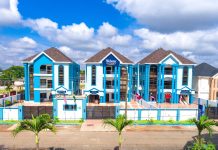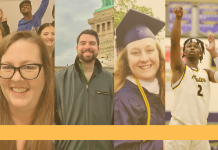Webster University admitted Janet Irene Tomas and Jeanette Mae Jackson, its first African American students, in 1946. Both graduated in 1950, prior to the Brown v. Board of education decision in 1954, establishing the school as a beacon of diversity and inclusion.

Through hiring the very first associate vice president for diversity and inclusion in 2013 to hosting DEI (Diversity, Equity and Inclusion) conferences annually since 2016, Webster has continued to try and uphold its promise of a commitment to social justice and racial equity.
However, as of 2021, the Black student graduation demographic has shown a continuous drop. Black students make up the lowest demographic of students to complete their education at Webster: 40% as compared to the national average of Black students at 45%.
Students held protests earlier in the semester critiquing the leadership of the school and other perceived failures of the university, such as limited funding and accessibility issues. Protesters raised concerns about the university’s DEI promise to grow the school as a space for Black students to succeed.
In 2013, Nicole Roach was hired as the associate vice president for diversity and inclusion but her position shifted to chief diversity officer. While hiring Roach was another step toward making sure Black students and all students of color were supported on campus, there was still more work to be done.
Roach detailed her experiences in her role in a self-published article in 2018.
“One common idea I came across – and challenged – was the idea that having a campaign or strategy to recruit Black or brown students ended when they enrolled. You have to build relationships with these students and their communities, which includes individuals and groups both inside and outside the walls of the institution,” Roach stated.
Former director of the School of Communications Internship Program, Trezette Dixon, echoed these sentiments, saying that Webster was great at emphasizing the importance of recruiting Black students to attend Webster, but that an emphasis was needed on retention.
About 11.8% of faculty overall who work for the university are Black. However, this is not unique to Webster and is reflected by other predominantly white institutions (PWI). The national average for Black faculty is just 6%.
“I’ve seen a lot of our private predominantly white institutions and yes, it can be very jarring at first for you to see the people of color in the jobs within service like your cafeteria, your maintenance … and not seeing them in the areas of faculty and executive-level positions. But, it’s not uncommon. That’s just the reality of a PWI,” Dixon said.
Emerald Dubose, president of the Association for African-American Collegians (AAAC), has been very vocal, especially with students within the Black community on Webster’s campus.
“There have been some issues brought up about some interactions between Black female [students] and professors … but at the same time [with] us being the minority, who’s to say that the situation even reached the people it needed to reach for it to even be handled?” Dubose said.

The combined lack of Black faculty and other issues raised brings into question – for students and faculty alike – whether Webster has been able to fulfill its DEI promise. Dixon stated that in order to fulfill its promise, Webster needs to increase the skills needed for non-Black professionals to engage respectfully with Black students and students of color. Making sure students feel represented in the classroom and around campus is also a key aspiration.
While Webster’s competency is being questioned by students in protest, there are some present on campus who are still finding support with groups like AAAC. The group submitted its first constitution in 2011 and has since remained active on campus.
AAAC is focused on diversity, community service and unity through hosting social events and, overall, raising awareness for important social issues concerning the Black community. While the organization is intended to service students within the African American community, it also reaches out to others.
Dubose has found there is a space for her here at Webster and hopes AAAC does the same for others.
“My goal has been to make sure that everybody feels safe and feels as if they have a space where they can come be vulnerable about whatever it is that they’re experiencing, good and bad,” Dubose said.
Webster’s journey as a hotspot for diversity starts at the beginning, and it seems there have been changes made over the years in an attempt to properly accommodate Black students. Dixon said she sees Webster as a beacon for other universities due to programs like the Suggs scholarship for students of color, among others.
“I think that in the next five years … if we could see investment in faculty and staff that resemble the student body, especially our African-American students, we will see the growth and retention of the university and not just the recruitment.”




